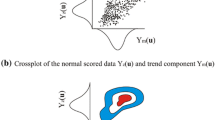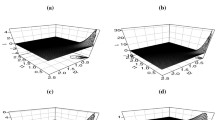Abstract
A common assumption in geostatistics is that the underlying joint distribution of possible values of a geological attribute at different locations is stationary within a homogeneous domain. This joint distribution is commonly modeled as multi-Gaussian, with correlations defined by a stationary covariance function. This results in attribute maps that fail to reproduce local changes in the mean, in the variance and, particularly, in the spatial continuity. The proposed alternative is to build local distributions, variograms, and correlograms. These are inferred by weighting the samples depending on their distance to selected locations. The local distributions are locally transformed into Gaussian distributions embedding information on the local histogram. The distance weighted experimental variograms and correlograms are able to adapt to local changes in the direction and range of spatial continuity. The automatically fitted local variogram models and the local Gaussian transformation parameters are used in spatial estimation algorithms assuming local stationarity. The resulting maps are rich in nonstationary spatial features. The proposed process implies a higher computational effort than traditional stationary techniques, but if data availability allows for a reliable inference of the local distributions and statistics, a higher accuracy of estimates can be achieved.










Similar content being viewed by others
References
Alabert F (1987) The practice of fast conditional simulations through the LU decomposition of the covariance matrix. Math Geol 19:369–386. doi:10.1007/bf00897191
Boisvert J, Manchuk J, Deutsch C (2009) Kriging in the presence of locally varying anisotropy using non-Euclidean distances. Math Geosci 41:585–601. doi:10.1007/s11004-009-9229-1
Borradaile G (2003) Statistics of earth science data: their distribution in time, space, and orientation. Springer, Berlin Heidelberg
Bourgault G (1997) Spatial declustering weights. Math Geol 29:277–290. doi:10.1007/bf02769633
Brunsdon C, Fotheringham A, Charlton M (2002) Geographically weighted summary statistics—a framework for localised exploratory data analysis. Comput Environ Urban 26:501–524. doi:10.1016/s0198-9715(01)00009-6
Chilès JP, Delfiner P (1999) Geostatistics: modeling spatial uncertainty. Wiley, New York
Cressie N (1985) Fitting variogram models by weighted least squares. Math Geol 17:563–586. doi:10.1007/bf01032109
Davis J (2002) Statistics and data analysis in geology. Wiley, New York
Deutsch C (2002) Geostatistical reservoir modeling. Oxford University Press, New York
Deutsch C, Journel A (1998) GSLIB: geostatistical software library and user’s guide. Oxford University Press, New York
Dimitrakopoulos R, Luo X (2004) Generalized sequential Gaussian simulation on group size ν and screen-effect approximations for large field simulations. Math Geol 36:567–591. doi:10.1023/B:MATG.0000037737.11615.df
Emery X (2010) Iterative algorithms for fitting a linear model of coregionalization. Comput Geosci 36:1150–1160. doi:10.1016/j.cageo.2009.10.007
Fotheringham A (1997) Trends in quantitative methods I: stressing the local. Prog Hum Geogr 21:88–96. doi:10.1191/030913297676693207
Fotheringham A, Brunsdon C, Charlton M (2002) Geographically weighted regression: the analysis of spatially varying relationships. Wiley, New York
Gómez-Hernández JJ, Cassiraga EF (1993) Theory and practice of sequential simulation. In: Armstrong M, Dowd PA (eds) Geostatistical simulations: proceedings of the geostatistical simulation workshop. Kluwer Academic, Fontainebleau, France
Goovaerts P (1997) Geostatistics for natural resources evaluation. Oxford University Press, New York
Gringarten E, Deutsch C (2001) Teacher’s aide variogram interpretation and modeling. Math Geol 33:507–534. doi:10.1023/a:1011093014141
Haas T (1990) Kriging and automated variogram modeling within a moving window. Atmos Environ, A Gen Top 24:1759–1769. doi:10.1016/0960-1686(90)90508-k
Harris P, Charlton M, Fotheringham A (2010) Moving window kriging with geographically weighted variograms. Stoch Environ Res Risk Assess 24:1193–1209. doi:10.1007/s00477-010-0391-2
Isaaks E, Srivastava R (1989) An introduction to applied geostatistics. Oxford University Press, New York
Journel A (1986) Geostatistics: models and tools for the earth sciences. Math Geol 18:119–140. doi:10.1007/bf00897658
Journel A, Huijbregts C (1978) Mining geostatistics. Academic Press, New York
Korvin G (1982) Axiomatic characterization of the general mixture rule. Geoexploration 19:267–276. doi:10.1016/0016-7142(82)90031-x
Machuca-Mory D, Deutsch C (2008) Location dependent variograms. In: Ortiz JM, Emery X (eds) Geostats 2008: proceedings of the eighth international geostatistics congress. University of Chile, Santiago, Chile, pp 497–506
Marchant B, Lark R (2004) Estimating variogram uncertainty. Math Geol 36:867–898. doi:10.1023/B:MATG.0000048797.08986.a7
Matheron G (1970) La théorie des variables régionalisées et ses applications. Cahiers du Centre de Morphologie Mathématique de Fontainebleau. Ecole des Mines de Paris
McLennan J (2007) The decision of stationarity. Dissertation, University of Alberta, Canada, 191 pp
Monestiez P, Switzer P (1991) Semiparametric estimation of nonstationary spatial covariance models by metric multidimensional scaling. Technical report, Stanford University, USA, 29 pp
Muñoz-Pardo JF (1987) Approche géostatistique de la variabilité spatiale des milieux géophysiques: application à l’échantillonnage de phénomènes bidimensionnels par simulation d’une fonction aléatoire. Dissertation, University Grenoble-1, France, 200 pp
Myers D (1989) To be or not to be… stationary? That is the question. Math Geol 21:347–362. doi:0882-8121/89/0400-0347506.00/1
Omre H (1984) The variogram and its estimation. In: Verly G, David M, Marechal A, Journel A (eds) Geostatistics for natural resources characterization proceedings of NATO ASI conference at Lake Tahoe, vol 1. Reidel, Dordrecht, pp 107–125.
Pardo-Igúzquiza E (1999) VARFIT: a Fortran-77 program for fitting variogram models by weighted least squares. Comput Geosci 25:251–261. doi:10.1016/s0098-3004(98)00128-9
Rivoirard J (1994) Introduction to disjunctive kriging and non-linear geostatistics. Clarendon Press, Oxford
Sampson PD, Guttorp PT (1992) Nonparametric estimation of nonstationary spatial covariance structure. J Am Stat Assoc 87:108–119
Vann J, Sans H (1996) Global resource estimation and change of support at the enterprise gold mine, pine creek, northern territory-application of the geostatistical discrete Gaussian model. In: Proceedings of APCOM XXV 1995: application of computers and operations in the minerals industries. Australasian Institute of Mining and Metallurgy, Brisbane
Verly G (1983) The multiGaussian approach and its applications to the estimation of local reserves. Math Geol 15:259–286. doi:10.1007/bf01036070
Wackernagel H (2003) Multivariate geostatistics: an introduction with applications. Springer, Berlin Heidelberg
Wasserman L (2006) All of nonparametric statistics. Springer, New York
Webster R, Oliver MA (1992) Sample adequately to estimate variograms of soil properties. J Soil Sci 43:177–192. doi:10.1111/j.1365-2389.1992.tb00128.x
Xu W (1996) Conditional curvilinear stochastic simulation using pixel-based algorithms. Math Geol 28:937–949. doi:10.1007/bf02066010
Acknowledgements
This research was supported by the industry sponsors of the Centre for Computational Geostatistics at the University of Alberta.
Author information
Authors and Affiliations
Corresponding author
Appendices
Appendix A: Locally Weighted Statistics
Weighted local univariate statistics have been previously presented as geographically weighted statistics (Brunsdon et al. 2002). For a set of calibrated weights \(\hat{\omega} (\mathbf{u}_{\alpha} ;\mathbf{o})\), α=1,…,n, anchored at point o, the local mean and variance are obtained from

and

Given a separation vector h, the locally weighted variograms are estimated by (Machuca-Mory and Deutsch 2008; Harris et al. 2010)

where ω′(u α ,u α +h;o) are the standardized 2-point distance weights and N(h) is the number of pairs separated by h. The local experimental covariance can be estimated as
The tail and head local means are obtained from
And the local experimental correlogram is estimated as

The required local tail and head variances are estimated by
Appendix B: Hermite Model of Local Gaussian Transformation
Given a number of quantiles z p (o) of the local distribution, the local Gaussian transformation function is approximated by (Journel and Huijbregts 1978; Wackernagel 2003)

H q [y p ] is the Hermite polynomial of order q, and the corresponding local coefficients ϕ q (o) are obtained by

Depending on the number of samples and the complexity of the cdf, between 50 to 200 local quantiles may suffice for the modeling of the local Gaussian transformation function. The expansion into Hermite polynomials allows for the approximation of the local variance (Rivoirard 1994)

In practice, expansions of degree 20 and 40 are commonly used (Vann and Sans 1996; Wackernagel 2003, p. 247).
Appendix C: Locally Stationary Simple Kriging Estimator and Variance
The locally-stationary simple kriging variance is expressed as

C Z (0;o) is equivalent to the location-dependent variance. The locally stationary simple kriging estimator is

with m(o)as the local mean.
Rights and permissions
About this article
Cite this article
Machuca-Mory, D.F., Deutsch, C.V. Non-stationary Geostatistical Modeling Based on Distance Weighted Statistics and Distributions. Math Geosci 45, 31–48 (2013). https://doi.org/10.1007/s11004-012-9428-z
Received:
Accepted:
Published:
Issue Date:
DOI: https://doi.org/10.1007/s11004-012-9428-z




